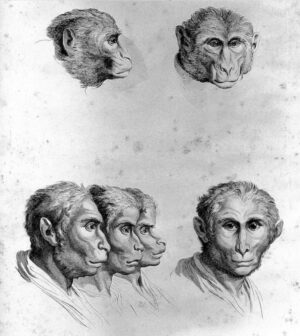
Here’s a simple equation which I believe has profound implications for how we understand our “selves”, also our life situation, past/present/future, and most importantly for our therapy journey together: how we deal with upset and suffering in our lives.
YOU = INSTINCTS/LIFE FORCE/ENERGY + NATURE/TEMPERAMENT/PERSONALITY + NURTURE/CULTURE/LIFE-CIRCUMSTANCES
Let me break that down a bit for us.
INSTINCTS/LIFE FORCE/ENERGY

We often forget that we are animals. Human animals, but animals nonetheless.
What kind of animals are we? We are mammals, we are primates. And like all animals, we are “ruled” to some extent by our instincts.
Instincts are very simply our natural, automatic behaviours and reactions that have evolved over time to help us survive and thrive. These instincts are innate and serve to guide us through various aspects of our life.
As you read about the three most important human-animal instincts below that make up (y)our “life force”, ask yourself the following all-important question as a human-animal: which of these instincts “dominates” my life as a living creature, by and large?
Even though we utilise all three instincts, generally speaking, our basic functioning relies more heavily on one instinct (our dominant instinct), followed by a secondary “assistant” instinct, while a third instinct is usually “repressed” or under-utilised in some way.
This is because our life-force isn’t limitless (both whilst alive, and clearly when dead), and so our nervous systems and innate, instinctual functioning is often forced to make automatic instinctive choices for us in terms of where we focus our energies.
When you read through the following needs and focus of each of your three instincts, have a think about where your life-force mainly gets channeled (this would be your dominant instinct), as well as which instinct isn’t being given enough energy or attention:
THE SELF-PRESERVATION INSTINCT’S NEEDS AND FOCUS:
Self-care and wellbeing:
(1) Diet, (2) exercise, (3) sleep/rest, (4) relaxation (time in solitude, walk in nature, meditation, yoga, etc.), (5) adequate stimulation (reading, listening to music, healthy sex life, watching documentaries, etc.)
Maintenance and resources:
(1) Money/finances, (2) time-management (self-management, time to self, time with others, being on time, etc.), (3) practical application and skills (being able to address practical needs, fix things, manage life, etc.), (4) work habits/persistence (the ability to follow through, finish tasks, discipline, habits around practical ventures, ways you are handy, etc.), (5) energy management ((how we use our energy, deal with stress, balance silence with activity, etc.)
Domesticity and home:
(1) Comfort/domesticity, (2) safety/security, (3) structure supports life/base of operations (home management, home as a solid launchpad), (4) beauty and holding (comfortable and inviting living/workspace, feeling held by your home, etc.), (5) recharging/restoration (home as a place to restore).
[Further exploration: Is Your Self-Preservation Instinct Balanced, Over-Dominant, or Impaired? How does the Self-Preservation Instinct function in your life and show up in your personality style?]
THE ONE-ON-ONE/SEXUL INSTINCT’S NEEDS AND FOCUS:
Broadcasting and charisma:
(1) Transmitting (initiating energy that broadcasts), (2) display (doing behaviours to get yourself noticed, (3) being attracted and following energy, (4) choosing/fitness (evaluating attraction; auditioning and being aware of being auditioned), and (5), competition/winning.
Exploration and edge:
(1) Activation and arousal, (2) taking risks and having adventures, (3) getting out of comfort zone (breaking habits and feeling soggy in routine), (4) seeking stimulation, and (5) following and honouring impulses and inspirations.
Merging:
(1) Disappearing into something or someone (which is restorative as it gets us away from the egoic self), (2) intense focus and concentration applied to an activity, (3) losing boundaries and sense of self, (4) spending energy (pouring self into something and giving self wholeheartedly), and (5) seeking fusion and at oneness.
[Further exploration: Is Your Sexual/One-on-One Instinct Balanced, Over-Dominant, or Impaired? How the Sexual/1-on-1 instinct function in your life and show up in your personality style?]
THE SOCIAL INSTINCT’S NEEDS AND FOCUS:
Reading people and situations:
(1) Reading facial expressions/body language/tone of voice/moods, (2) reading between the lines, (3) interest in others/attunement/tuning in, (4) empathy/concern, and (5) adapting to cures/adjusting behaviour.
Connecting:
(1) Creating relationships: engaging others, (2) sustaining relationships: maintaining connections and knowing when to end them, (3) communication—speaking and listening, (4) cooperation/reciprocity and (5) play/shared enjoyment/celebration.
Participation:
(1) Getting involved or not: what do I participate in?, (2) need to contribute: something beyond my own needs, (3) enrolling: getting others interested and involved in what I am passionate about, (4) part of something bigger/sense of place, (5), belonging and welcoming.
[Further exploration: Is Your Social Instinct Balanced, Over-Dominant, or Impaired? How the Social Instinct function in your life and show up in your personality style?]
Instincts generally work and shows up for us subconsciously. This means that we might be thinking or feeling or behaving in certain ways that are largely governed by our instincts, even though we are unaware of them at work within us.
As we seem to be dominated by ONE of the three instincts, as well as under-utilising aspects of the other two, it can be helpful to consider ways in which we balance our instinctual drives throughout the day, as well as in our lives in general.
This is something we can discuss more when we meet and begin to reflect on your life and the situations you are dealing with at the moment.
NATURE/TEMPERAMENT/PERSONALITY

“You” were once a baby. Babies don’t have fully-formed and expressive ego-functioning styles (aka personalities) which usually only come online in mid-childhood. But even as infants, we all have a very definite temperament or “nature”.
Regardless of our environment when growing up, some babies are more social, or playful, others less so. Some babies are generally quite compliant or easy-going, others are more difficult or demanding. Again, like our instincts, this stuff is just hard-wired into us as human-animals.
As with our instincts, we often forget or downplay our “natural temperament” when it comes to assessing or thinking about our lives, which can cause a great deal of emotional pain and suffering as our expectations on ourselves (as well as others) might be completely out of whack with who we really are and how we function, for better and for worse.
Our adult personality style is really just the “flowering” or “above ground” aspect of our temperamental/instinctual roots. This style will be affected by our upbringing to some extent (see the next section: NURTURE), just as a plant will grow in a more robust way in certain environments rather than others. But it’s probably wise to understand first and foremost whether we are a rose bush, or an orchid, or a sunflower.
Unlike plants we have a nervous system wired up to a brain stem, as well as a right and left-hemisphere which allows for more complex processing of our instincts and natural inclinations.
When our dominant instinct (self-preservation, social, or one-to-one/sexual) is combined with our core personality type, we get a more nuanced understanding of our personality (i.e. a subtype).
NURTURE

The interplay between nature (genetics) and nurture (environmental factors) is complex and multifaceted, making it difficult to determine the precise extent to which our life-force/instincts + temperament/nature/ego functioning are influenced by upbringing and trauma. However, it is widely accepted that both nature and nurture play significant roles in shaping our personality, temperament, and ego.
Some key aspects of the nurture side of things which would be good to explore together when understanding “you” and how you show up in the world include: parenting styles, cultural influences, socio-economic status, and traumatic experiences. These factors can contribute to the formation of an individual’s temperament and ego functioning, but they don’t necessarily alter our basic instinctual and temperamental settings.
It is important to note that the influence of environmental factors can vary from person to person, depending on individual genetic predispositions and resilience. Some people may be more susceptible to the effects of upbringing and trauma, while others may be more resilient.
Understanding the complex interplay between nature and nurture is essential understanding how you function, and is built into the Five Factors that constitute my integrative way of doing psychotherapy.
This is something we will always need to bear in mind when thinking about “you”.
THREE WAYS TO BE ONE

SELF-PRESERVATION ONES
Self-Preservation Ones seek to experience Essential Integrity through their lifestyle and well-being, and they put a great deal of energy into determining the best way to live in accordance with their values. For this type, living with integrity means making sure the choices they make correspond to their principles. Every area of life is considered and scrutinised: the right diet, work, hygiene, and even how the day is structured and how time is spent, because creating coherence between their personal values and how they are expressed in micro and macro details help the Self-Preservation One find clarity, orientation, and purpose.
Self-Preservation Ones are deeply considerate of aspects of their lives that most people take for granted. They may, for example, be inclined to put in the extra time and research to avoid purchasing personal products that were tested on animals and find those that are ethically sourced, and they may go several steps further to make sure that reforms and improvements are applied to areas where standards or integrity seems to be lacking. For this reason, many Self-Preservation Ones take an interest in politics, law, and other systems that regulate the flow of resources and sustainability, seeking the maximum fairness and justice. It’s also common for Self-Preservation Ones to have a deeply curious side that lends itself to thorough investigations or philosophical inquiry that may be expressed as a kind of reveling in awe of the patterns and intelligence they find in natural systems, like the environment or astronomy.
Many Self-Preservation Ones can exhibit a great deal of anxiety around lifestyle choices. Their home, for example, is often the object of emotional fuss. Contrary to stereotypes, it’s not always the case that Self-Preservation Ones’ living spaces are perfectly tidied and ordered, but there is almost always some clear intentionality. It might be aesthetically “just right,” it might represent an ideal environment for caring for a family, or it might be an expression of a particular kind of lifestyle.
Self-Preservation Ones are also typically quite frugal and have strong boundaries around money and can be surprisingly intense about territory and exerting control over their autonomy. They can emphasise correct procedures and correct habits, in themselves and in others. For distressed Self-Preservation Ones, there is little room for disruptions or flexibility outside narrow parameters. Therefore, punitive self-control can be met with “leaks” whereby the One tries to release some of the pressure built up around their harsh inner critic, such as being extremely choosy around their diet and then binging on sugar after a lengthy period of “good behaviour.”
This type has an especially strong sense of how the mundane details of life are connected to a feeling of something sacred, divine, or at least purposeful, and thus, like all Type Ones, there is often an underlying feeling of grief in regards to the world. Unlike Social and Sexual Ones, in trying to live according to “the right way”, Self-Preservation Ones may suffer from painting themselves into a corner, of living overly limited lives lacking experimentation and spontaneity. As they grow older, if they haven’t been doing their inner work, they may have added layers of heartbreak over how the living of their life has failed to match the sense of importance of the values they hold dear due to an overly restricted sense of how those values are best honoured.
In attempting to avoid feelings of being flawed, the imbalanced Self-Preservation One will feel a need to justify the correctness of their lifestyle, leading to some rather bizarre rationalisations for the way they live and how others ought to be, especially when physical and emotional needs arise that don’t fit cleanly within their ideals.
Hypochondria, fears of contaminated food, and excessive cleanliness can be warning signs that the Self-Preservation One is under stress and trying to maintain ever-strong ego-boundaries by stamping out impurities. As they psychologically disintegrate, they may attempt to exert even greater control over their environment, which may mean angrily rejecting and defending against people who threaten their sense of order and control.
When Self-Preservation Ones relax into the chaos of living in an animal body, they gain clarity about how they can help make life a little easier for themselves and others, and they can learn to channel their drive into making the world a kinder place, not just a more orderly one.
SEXUAL ONES
Sexual Ones seek to experience Essential Integrity in their sexual relationships and attraction displays. The idealism of Type One manifests here most acutely as attempting to be the best kind of romantic partner, to have the best partner, and to have an untouchable kind of chemistry. They’re not so much interested in appearances, though they certainly give it attention; instead, they aim to exemplify traits that make them exceptional and therefore desirable. In turn, they look for a partner who shares these qualities, the kind of partner with whom they can have the “right” kind of relationship.
In contrast to the stereotype of the straight-laced One, Sexual Ones often have hobbies, interests, and careers that may seem out of bounds for a type that is typically perfectionistic. These interests can often seem, on the surface, unrelated to attraction, but their “hook” is that they’re usually fascinating, adventurous, or creative, and performed to a high enough standard of excellence that it stands out.
By seeming to be rooted in an ideal other than attraction, their attraction-displays also serve the additional purpose of giving the Sexual One’s ego “plausible deniability” that these activities are sought for a higher purpose than just procuring sexual attraction.
Sexual Ones are usually very sexually free and expressive, yet they may judge the sexual dynamic for not being reflective enough of certain values or not being up to par as lovers. Autonomy plays a central role in the Type One personality, so the judgment that they direct at themselves, at lovers, and the relationship as a whole unconsciously functions to reinforce separateness. If the partner is too X, Y, or Z to infuse themselves with, or the Sexual One judges themselves to be unworthy or not good enough for their partner, this may present emotional difficulties. But overall, judgment serves to keep the One feeling sovereign and clear of the corrupting, messy elements in reality.
Sexual Ones often have an ideal kind of partner in mind, but their bodies may betray an attraction to people that don’t accord with their ideals. They may seek out partners who hit every box on their checklist but are poor lovers, or vice-versa. This can pit a Sexual One against themself in a clash between standards and reality, and there may be an unconscious dynamic of being turned on by their own frustration toward their partner. Sexual Ones are often attracted to partners who offer some kind of escape from the tight reins of their inner judgment or tempt some kind of transgression, and they may mistakenly read edginess into a partner. Having a rebellious partner gives their superego an excuse to indulge in seductions that may not seem appropriate to their standards, yet they may then judge their partner for being the transgressor.
Sexual Ones can have an infatuation for the ideal. They may unconsciously create conditions where they either keep a relationship with a potential partner from being consummated or they become obsessed with unobtainable lovers, believing that this person is “perfect” for them. Sexual Ones may become attracted to the impossibility of being with the other person. When they actually have a relationship, they may shift most of their energy toward their attraction display and away from their partner, leaving the partner feeling ignored. Not trusting in attraction, the Sexual One will continuously invest energy into what they believe makes them enticing, sometimes at the expense of their actual relationship. All of this functions to preserve a false sense of autonomy for the Sexual One when they don’t trust in attraction or their body.
Underneath it all, Sexual Ones typically hold an unobtainable romantic ideal of total sexual union with another, but it is a standard so high that no human being can meet them there. This, ultimately, is a means of unconsciously preserving the One’s autonomy and keeping their frustration going. For the Sexual One, to really embrace another person on these deeply intimate levels risks contaminating a core sense of the sacred, which, itself, betrays a distrust of the integrity of their inner sense of the sacred.
Unbalanced Sexual Ones can become deeply neurotic around fidelity and extremely jealous of their partner’s sexual history and past relationships. To protect themselves from fears of rejection and undesirability, Sexual Ones may strive to be such a perfect catch that they will either be unrejectable or have reasons to reject their partner before they themselves are rejected. They may alternate between voracious sexual obsession and sexual repression. In partnerships, Sexual Ones can become ruthlessly critical and controlling of their partners, as if getting a thrill from turning partners into improvement projects.
Sexual Ones can learn to relax when they recognise that they can’t control attraction. This can allow them to both not judge themselves for who or what they find attractive and also let themselves off the hook for not behaving to their own ideals.
SOCIAL ONES
Social Ones are looking to experience Essential Integrity in relationships, causes, and vocation. Social Ones tend to have a great deal of awareness about what’s going on in the world at large.
They want to understand their place in it and how they can meaningfully contribute to its betterment. The Social Drives’ desire to contribute to others is especially strong when paired with the Type One’s sense of responsibility and obligation. People of this type tend to be reformers, social crusaders, and standard bearers. They have a sense of mission and purpose and wish to set an example of how to live from integrity.
Social Ones are often talented and creative, with a tendency toward intellectual interests. People of this type experience an enormous sense of responsibility and care for others, with a desire to reform their social sphere according to their standards. They can be the most effusive and warm flavour of One. Their sensitivity to context makes Social Ones naturally adept at seeing both the potential in others as well as where others fail to live up to it. This often has them gravitate toward mentoring, teaching, guidance, coaching, or leadership positions where they can foster the growth of individuals.
Many of the most influential social reformers and revolutionaries have been Social Ones who’ve been able to harness the power of the Social Instinctual energies toward building a better world and inspiring powerful change.
In the Social One, autonomy conflicts come into play as a desire to become attached to a particular social set while finding that group to be not quite up to their ideals. Thus, the relationships and connections they seek to foster are in need of improvement. This keeps the Social One both engaged and oriented toward particular dynamics and people, yet on the outside. By being critical of them, they remain autonomous and separate. Underneath their judgments is often a deep compassion and empathy, but in their striving to uphold their principles, they may inadvertently harden their hearts.
Although their impulse to reform is well-meaning, as their ideals become more rigid and unrealistic, their judgments become more intense. Unconsciously, the imbalanced Social One is perpetually striving for moral superiority, which comes into conflict with the desire for connection and the Social Instinct’s awareness of others’ states. Social Ones can play out chronic frustration and judgment of loved ones and groups as a way to remain both separate from them and attached through a negative affect. This can narrow their focus to people or topics that are outside their control which unconsciously act as “blinders” to keep their self-expression and self-exploration, and thus their ego-boundaries, limited and their deeper self unexplored. To keep up the identity, no matter how others actually are, the entranced Social One will have to find fault and come from a position of judgment and condemnation.
The pathological Social One can become a zealot for their visions of how society should be, taking on an air of purifying the social climate. They can become wedded to principles that have little bearing on reality, and they will insist others abide by them. Many well-intentioned Social Ones can come to support views that are idealistically attractive, yet in practice may have toxic consequences.
An identification with feeling right can prevent them from being willing to see how their ideals may not work out as imagined.
Additionally, when imbalanced, they can become obsessed with retribution and punishment, seeking harsh consequences for offenders of a desired social order or against those seen as oppressors, criminals, or tyrants, leading them to cross ethical lines they would never have imagined they’d cross.
Social Ones can learn to recognise that their frustration and impulse to judge stem from their deep care. Being in touch with that sense of care can help the Social One to recognise their own distressed state with impartial acceptance so as to relax into the felt sense of belonging and connection.
[Source: Luckovich, 2021]
